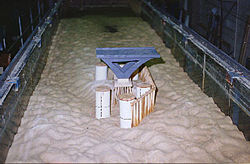U.S. Department of Transportation
Federal Highway Administration
1200 New Jersey Avenue, SE
Washington, DC 20590
202-366-4000
Focus
| Accelerating Infrastructure Innovations |
Publication Number: FHWA-RD-01-061
Date: February 2001
With construction nearly ready to begin on the new 12-lane Woodrow Wilson Bridge just outside of Washington, DC, last year, engineers found themselves concerned about the depth of the scour that might form around the bridge piers. Scour, which is the erosion of stream bed material around bridge foundations, is the leading cause of bridge failures in the United States. In designing the bridge over the Potomac River, engineers realized that the combination of large river piers, high river velocities, and a complex soil structure under the river presented particular challenges. The pipe piles supporting the river piers had to be founded deep enough to make the bridge stable against the worst case scour expected to occur.
 |
| The Woodrow Wilson Bridge model is tested for scour in FHWA Hydraulics Lab. |
The Maryland State Highway Administration, Federal Highway Administration (FHWA), and several consultants involved in designing the bridge turned to FHWA's Hydraulics Laboratory at the Turner-Fairbank Highway Research Center in McLean, Virginia, for assistance in predicting the scour at the new bridge and also at selected piers on the existing bridge, which will remain in service for several years while work proceeds on the new structure.
Researchers at the lab used a combination of advanced numerical and physical scale modeling to simulate the flow and sediment transport conditions at the bridge and the resulting scour at the piers. Traditional research on pier scour has concentrated on sand channels, whereas the Potomac River bed is comprised in part of cohesive soils such as silt and clay. Taking into account these cohesive soils, a special design technique known as the Erodability Index Method was also used in the scour evaluation. This method checks the erosion resistance of different types of soil bed materials. "That isn't something we can very readily model in a hydraulic lab," says Sterling Jones of FHWA and manager of the Hydraulics Laboratory. "The index method provides a way to analyze the erosion resistance of various soil strata up to the maximum expected scour depth. This was the first time the index method had been applied to a major bridge design like this one." The resulting scour depths obtained from the models and the erodability index evaluations were significantly less than values obtained using the standard pier scour equation in the current FHWA guidelines.
During the design process, a number of alternative pier designs were studied. The Hydraulics Lab evaluated these alternative designs and provided immediate feedback on the scour depths to the bridge engineers. The accuracy of the FHWA lab studies was validated by selected larger-scale tests at the U.S. Geological Survey Biological Research Division lab in Turners Falls, Massachusetts.
The scour evaluations were part of a process that led to substructure design changes that are expected to make the bridge safer and more cost-effective. Savings will result from reducing the predicted scour depths by an average of 4.5 to 6 m (15 to 20 ft), using fewer but larger piles, and incorporating vertical piles instead of battered piles, which are more difficult and expensive to install. Another major benefit is that engineers gained a greater understanding of how vessel impact structures, which are placed around the bridge's foundations to prevent collisions, affect the scouring process. Lab tests revealed that the concrete structures, known as dolphins, proposed for protecting the main river piers from ship collisions would dramatically increase scour at the piers. This finding led to changing the design to use a fender ring protection system that extends all the way around the piers. Using the protective ring instead of the dolphins is expected to reduce the maximum scour by nearly half and provide better protection from vessels at no additional cost.
The scour studies served to validate a more accurate method for estimating scour at complex piers. Information on this method and the Erodability Index will be included in the next edition of FHWA's Hydraulic Engineering Circular No. 18, which contains the standard guidance on bridge scour.